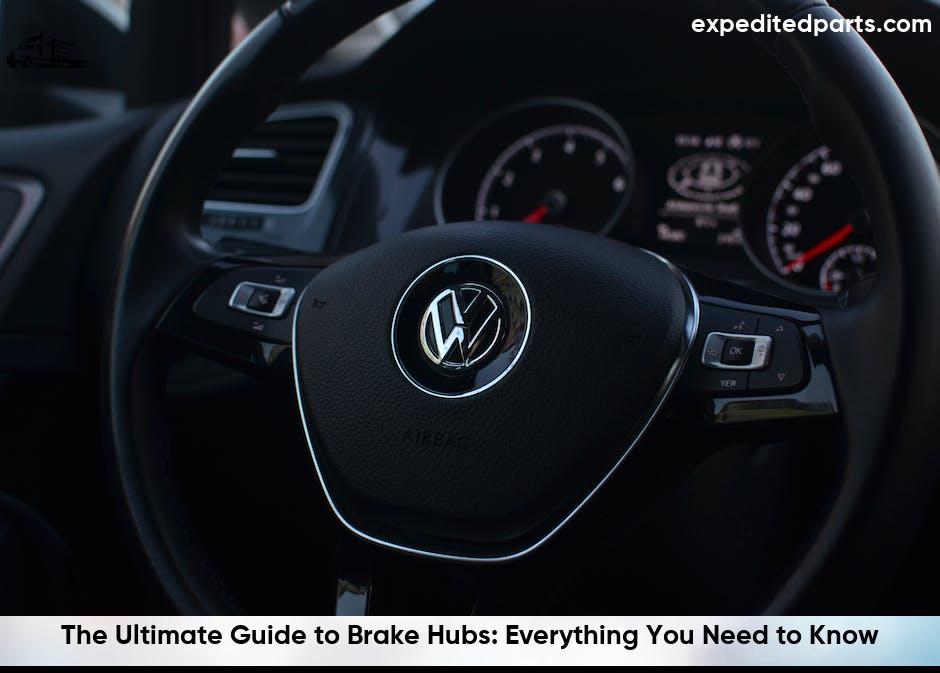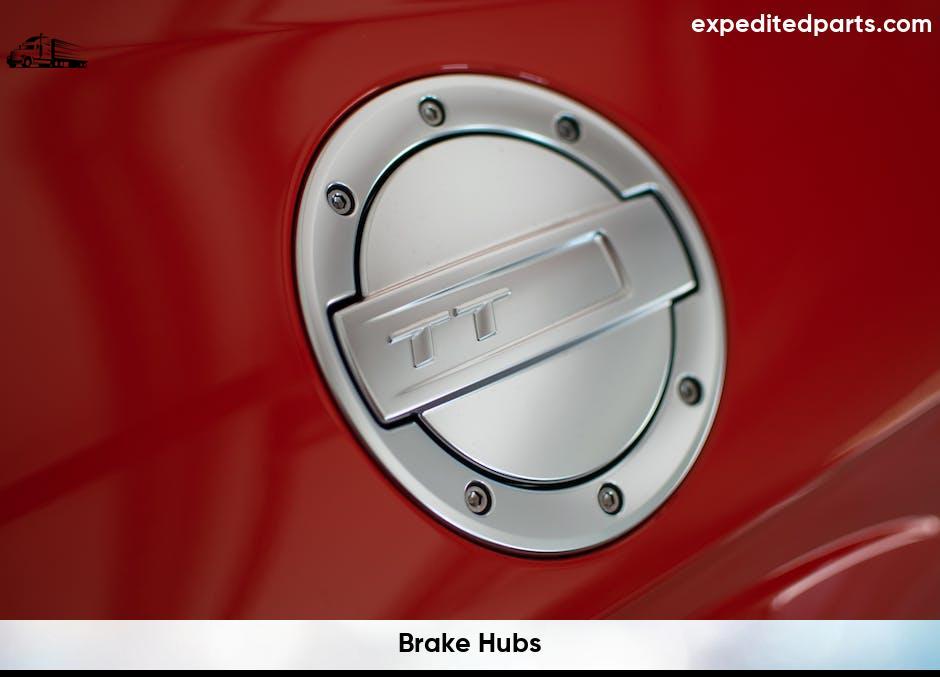Brake hubs play a crucial role in the functioning of a vehicle’s braking system. Located at the center of the wheel, these hubs are responsible for connecting the wheel to the axle and transmitting the braking force. They house the brake rotor, which is clamped by the brake caliper to create friction and slow down or stop the vehicle. Brake hubs are designed to withstand extreme heat and pressure generated during braking, ensuring optimal performance and safety. They are typically made from durable materials such as cast iron or aluminum alloy, and their design varies depending on the type of braking system used in the vehicle. Proper maintenance and regular inspections of brake hubs are essential to ensure their efficiency and prevent any potential brake failures.
 : The Ultimate Guide to Brake Hubs: Everything You Need to Know
: The Ultimate Guide to Brake Hubs: Everything You Need to Know
The Ultimate Guide to Brake Hubs: Everything You Need to Know
When it comes to your vehicle’s braking system, the brake hubs play a crucial role in ensuring optimal performance and safety. It is important to have a good understanding of brake hubs and how they impact your vehicle’s braking capabilities. This comprehensive guide will provide you with all the essential information you need to know about brake hubs.
What are Brake Hubs?
Brake hubs are the components of a vehicle’s braking system that connect the wheels to the rest of the braking system. They are responsible for mounting the brake rotors and provide a mounting point for the brake calipers. Brake hubs are typically made of high-strength materials such as cast iron or steel, ensuring durability and reliability.
Types of Brake Hubs
There are two main types of brake hubs: solid hubs and hub assemblies. Solid hubs are a single piece that includes the wheel studs and the brake rotor mounting surface. Hub assemblies, on the other hand, consist of multiple components, including the hub, bearings, and seals, all integrated into a single unit. The choice between solid hubs and hub assemblies depends on the specific vehicle make and model.
Signs of Brake Hub Problems
- Poor braking performance
- Uneven brake pad wear
- Loose or wobbly wheel
Choosing the Right Brake Hubs
When selecting brake hubs for your vehicle, it is essential to consider various factors, including compatibility with your vehicle’s make and model, performance requirements, and budget. Additionally, ensure that the brake hubs meet the necessary quality and safety standards to ensure reliable and efficient braking.
Maintenance and Replacement
Regular maintenance of brake hubs is crucial for optimal performance and longevity. This includes inspection for damage, worn components, and proper lubrication. If any signs of wear or damage are evident, timely replacement is necessary to prevent further damage to the braking system and ensure safe operation of your vehicle.
In conclusion, having a good understanding of brake hubs is essential for maintaining a reliable and efficient braking system in your vehicle. Make sure to choose the right brake hubs that are compatible with your vehicle and meet the necessary quality and safety standards. Regular maintenance and timely replacement will ensure the longevity and performance of your brake hubs, leading to improved braking capabilities and enhanced safety on the road.
: Choosing the Right Brake Hubs for Your Vehicle: A Comprehensive Guide
Choosing the Right Brake Hubs for Your Vehicle: A Comprehensive Guide
Choosing the right brake hubs for your vehicle is crucial for ensuring optimal braking performance and safety. With a wide range of options available in the market, it can be overwhelming to determine the best brake hubs that suit your specific vehicle make and model. This comprehensive guide will provide you with all the necessary information to make an informed decision when selecting brake hubs.
Compatibility
Before purchasing brake hubs, it is essential to ensure compatibility with your vehicle’s make and model. Brake hubs come in various sizes, designs, and specifications, and selecting the wrong ones can lead to poor braking performance and potential safety issues. Consult your vehicle manufacturer’s recommendations or seek advice from a trusted mechanic to ensure the perfect fit.
Brake Hub Materials
Brake Hub Types
There are two main types of brake hubs: solid hubs and hub assemblies. Solid hubs are a one-piece design that includes the wheel studs and the brake rotor mounting surface. Hub assemblies, on the other hand, consist of multiple components, including the hub, bearings, and seals, all integrated into a single unit. Each type has its own advantages and considerations, so choose the one that best fits your vehicle’s requirements.
Quality and Reliability
When selecting brake hubs, it is important to prioritize quality and reliability. Opt for reputable brands and ensure that the brake hubs meet industry standards and regulations. High-quality brake hubs not only ensure optimal braking performance but also offer enhanced durability, reducing the need for frequent replacements and potential safety risks associated with substandard products.
Budget Considerations
While it is important to prioritize quality, considering your budget is also essential. Brake hubs are available in a wide price range, and it is possible to find options that meet your requirements without breaking the bank. Compare prices from different suppliers and consider the warranty and reliability of the product to make an informed decision that aligns with your budget.
Installation and Maintenance
In conclusion, choosing the right brake hubs for your vehicle is a crucial decision that impacts braking performance and safety. Consider factors such as compatibility, brake hub materials, types, quality, and budget to make an informed choice. Prioritize quality and reliability, and ensure proper installation and regular maintenance for optimal performance and longevity of your brake hubs.
Brake Hubs 101: Understanding the Basics for a Safer Ride
Components of Brake Hubs:
- Hub Shell: This is the outer, protective covering of the hub that houses the internal components.
- Bearings: These small, spherical objects facilitate smooth rotation of the hub by minimizing friction.
- Brake Rotor Mount: Brake rotors are attached to the hub via this mounting point, allowing for effective braking.
Types of Brake Hubs:
- Rim Brake Hubs: These hubs are designed for use with rim brakes, where the brake pads directly contact the rim to slow down or stop the bicycle.
- Disc Brake Hubs: These hubs are specifically designed for use with disc brakes, which utilize a rotor attached to the hub and calipers to provide braking force.
Choosing the Right Brake Hub:
- Determine your braking requirements and choose a hub type accordingly.
- Consider factors such as weight, durability, and compatibility with your bicycle.
—————————————————-
The Latest Innovations in Brake Hubs: What You Need to Stay Ahead
New Materials and Construction:
- Carbon Fiber Hubs: These hubs, made from lightweight and durable carbon fiber material, offer a perfect balance between strength and weight reduction.
Enhanced Brake Performance:
- Hydraulic Disc Brakes: Hydraulic systems provide better modulation and consistent braking performance, even in wet or challenging conditions.
- Heat Dissipation Technology: Innovative hub designs incorporate heat dissipation features to prevent brake fade and improve overall braking effectiveness.
Smart Brake Hubs:
- Integrated Sensor Systems: Some brake hubs now come equipped with sensors that monitor brake pad wear, temperature, and even alert the rider in case of any malfunction.
- Wireless Connectivity: Advanced brake hubs can now connect to smartphones or cycling computers, allowing riders to monitor and analyze their braking performance in real-time.
Future Developments:
- Improved Aerodynamics: Manufacturers are focusing on developing brake hubs with sleek and aerodynamic designs to minimize wind resistance for a more efficient ride.
By staying updated on the latest innovations in brake hubs, you can make informed decisions when it comes to choosing the right equipment for your vehicle or bicycle. These advancements not only contribute to improved safety but also enhance your overall riding performance.
- Squeaking or squealing noise: If you notice a high-pitched noise coming from your brake hubs when you apply the brakes, it could be due to worn-out brake pads. Replace the brake pads and inspect the brake rotors for any damage.
- Vibrations or pulsations: If you feel vibrations or pulsations in the brake pedal when you apply the brakes, it may indicate warped brake rotors. Have the rotors resurfaced or replaced to restore smooth braking.
- Brake fluid leakage: Check for any signs of brake fluid leakage around the brake hubs. This could be due to a faulty brake caliper or brake line. Replace or repair the damaged components to prevent loss of braking power.
- Uneven brake pad wear: If one brake pad wears down faster than the others, it can cause uneven braking and decrease stopping power. Inspect and replace the brake pads if necessary, and check for any underlying issues such as stuck caliper pistons.
Remember, if you are unsure or uncomfortable with performing brake hub repairs yourself, it is always best to consult a professional mechanic. Maintaining your brake hubs in good condition is crucial for your safety and the overall performance of your vehicle.
Boost Your Vehicle’s Performance with High-Quality Brake Hubs
When it comes to upgrading your vehicle’s performance, one component that should not be overlooked is the brake hubs. High-quality brake hubs not only improve your vehicle’s stopping power but also enhance overall performance. Here are some key benefits of investing in high-quality brake hubs:
- Heat dissipation: Upgraded brake hubs are engineered with superior heat dissipation properties. This helps prevent overheating during prolonged or aggressive braking, reducing the risk of brake fade and maintaining consistent performance.
- Durability and longevity: High-quality brake hubs are constructed from durable materials that can withstand heavy usage and frequent braking. They have a longer lifespan compared to standard brake hubs, reducing the need for frequent replacements.
When considering upgrading your brake hubs, it is essential to choose a reputable brand known for its quality and performance. Consult with a trusted automotive specialist to find the best high-quality brake hubs that suit your vehicle’s specific needs. By investing in top-notch brake hubs, you can significantly improve your vehicle’s overall performance and safety.


